


Part.1
introductory
![]()
![]()
![]()
![]()
![]()
![]()
![]()
![]()
![]()
With the advancement of science, technology and living standards, there is an increasing demand for high quality indoor environments in buildings. Given that visual information accounts for more than 90% of daily external information intake, lighting plays a crucial role as a key component of visual information. Prolonged exposure to substandard lighting conditions can lead to visual fatigue, headaches, lack of concentration, increased rate of operational errors, and so on. Current research focuses on lighting parameters, including spectrum, illuminance, relevant color temperature and lighting settings, and the standards for these parameters only provide basic values to meet the needs of the activity without sufficient consideration of the comfort and health needs of the user, which may be related to the failure of the lighting assessment to effectively reflect the impact of the indoor light environment on the individual's psychological response. Lighting environment evaluations mainly include subjective questionnaires, interviews and behavioral tests. However, most of these data suffer from problems such as time lag. Advances in physiological measurement techniques have enabled the collection of immediate data on how the light environment affects individual psychophysiological responses.
Light is converted into electrical signals by photoreceptors in the retina, which are then transmitted through optic nerve fibers to the brain and ultimately to the cerebral cortex. However, EEG technology can record electrophysiological activity in the cerebral cortex. This paper provides an overview of the use of EEG technology in indoor lighting environments over the past 20 years and aims to highlight the progress made in the field, as well as future directions for research and applications in the field.
Part.2
How the EEG reflects the effects of the light environment on the individual
![]()
![]()
![]()
![]()
![]()
![]()
![]()
![]()
![]()
When stimulated by the light environment, ion channels (Na+ and K+) on cell membranes become active. Neurons strive to achieve a dynamic equilibrium between the resting state when they are at rest and the excited state, resulting in rhythmic fluctuations of neuronal populations in the brain, and these rhythmic fluctuations provide an objective and effective method for studying the light environment. EEG signals are acquired by placing electrodes on the subject's scalp according to the International 10-20 system. More electrodes can be selected to improve the accuracy of the data, but some studies have selected only some of the electrodes to improve the comfort of the subjects and the efficiency of the experiment. In conclusion, in principle the electrodes should be evenly distributed on the scalp.
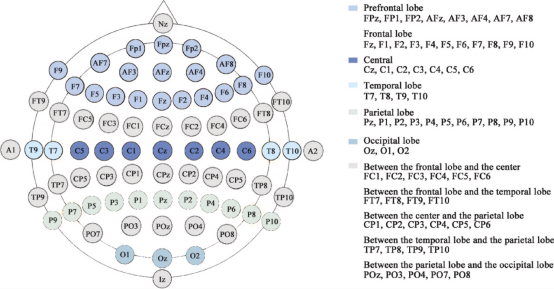


EEG signals are acquired as waveforms of amplified potentials, and different event-related potentials (ERPs) are distinguished on the basis of the shape and temporal characteristics of the waveforms, and the amplitude and latency of specific ERPs can be used in the analysis of light environment studies. Amplitude correlates with the strength of the brain response triggered by the light stimulus, while latency correlates with the speed of the brain's processing of the light stimulus. Studies have shown that the interaction of external stimuli with the brain's nervous system in a time series can be obtained from EEG. Thus, EEG can provide insights into how the illumination environment affects an individual's psychological , physiological responses and behavioral changes.
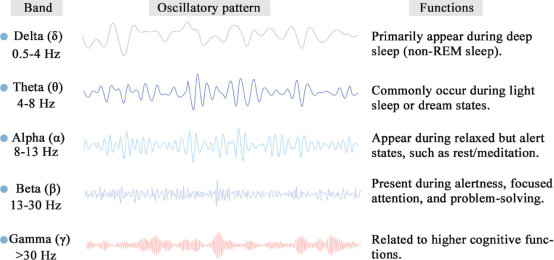


Part.3
Electroencephalography in light environment research
![]()
![]()
![]()
![]()
![]()
![]()
![]()
![]()
![]()
The chapter focuses on summarizing and synthesizing the role of EEG in assessing indoor light environments, and its highlights the validity of EEG in assessing indoor light environment conditions, particularly with regard to how spectrum, illuminance, color temperature, and lighting patterns affect brain activity.
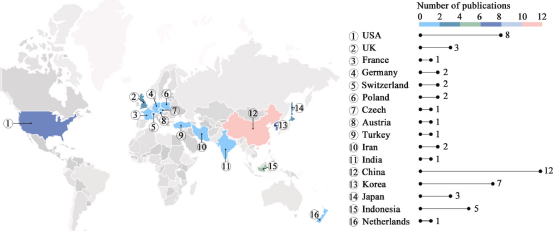





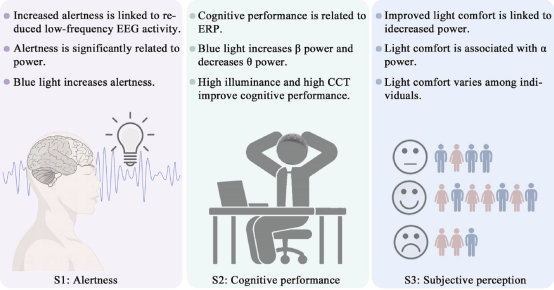


For light environment research, there are three main subcategories, one of which focuses on the effects of indoor light environments on alertness. Alertness is the nervous system's response to changes in the external environment and is closely related to neural activity and chemical release in the brain. The second focuses on the use of EEG to assess the effects of indoor lighting on the performance of cognitive activities. When the brain receives stimuli from the light environment, the brain sends out commands, and during cognitive processes the brain reallocates attentional resources, thus affecting cognitive performance. The third is based on the strong correlation between EEG signals and subjective perception to study the effect of indoor lighting environment on comfort.
Although many theoretical studies have revealed the effects of EEG signals on individuals in indoor light environments, there have been few real-world applications. Studies have shown that there are individual differences in how light environments affect comfort and behavior. In order to improve comfort and energy efficiency, it is necessary to build personalized indoor light loop control systems in the future.
Part.4
Spectrum, illuminance, correlation color temperature and illumination settings
![]()
![]()
![]()
![]()
![]()
![]()
![]()
![]()
![]()
The perception of color is transmitted via the optic nerve to the visual cortex of the brain, where neurons exhibit specific responses to various color stimuli. Studies have shown that blue light has a greater effect on brain activity, significantly suppressing low-frequency brain activity and activating high-frequency brain activity. Illumination is an important aspect of light, affecting the activation of neurons in the visual cortex, suppressing melatonin secretion, and more. Studies have found that conditions of illumination affect the brain's early attention processing. Interestingly, the effect of illumination on brain activity also varies depending on the visual content.
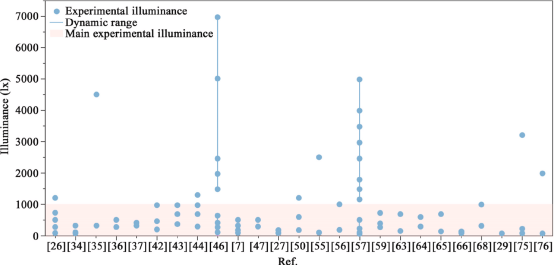


In summary, indoor environments have a significant effect on brain activity, and EEG technology provides an effective means of assessing this effect. Low-frequency EEG is associated with a relaxed state, while high-frequency EEG is associated with a state of awake consciousness. Factors such as blue light, high illuminance and high correlated color temperature have been shown to significantly and consistently low-frequency EEG activity and activate high-frequency EEG activity, contributing to increased alertness and improved cognitive performance.
Part.5
Improvements in the assessment of the light environment by electroencephalography
![]()
![]()
![]()
![]()
![]()
![]()
![]()
![]()
![]()
Experimental conditions: Many of the studies were conducted in laboratories in order to avoid interference from irrelevant factors, but there is still a need for field studies;
Subjects: Studies have shown that factors such as gender and age affect the results of experiments, and most of the subjects in the studies already conducted were 20-28 years old, so the sample size could be expanded in the future to include a wider group of subjects for a comprehensive analysis;
EEG devices: portable EEG is growing rapidly as technology develops, but gel electrodes dry out over time, limiting the length of time, and the performance of the devices can be further improved in the future;
DATA ANALYSIS: Common EEG analyses include time-domain, frequency-domain, and nonlinear features, which provide different insights into the presence of brain activity and need to be selected based on specific studies.



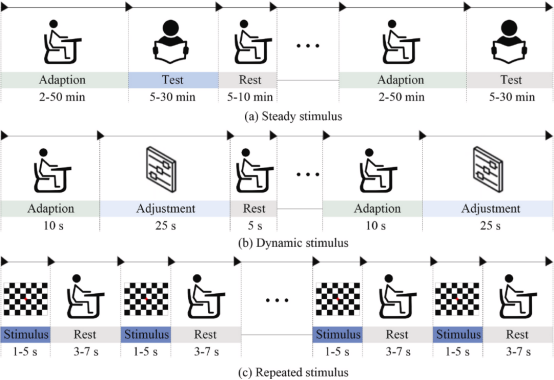


Part.6
Outlook
![]()
![]()
![]()
![]()
![]()
![]()
![]()
![]()
![]()
Several studies have developed classification models based on EEG signals to accurately predict comfort and cognitive performance in indoor light environments, but the activation of the frequency bands of each brain region changes significantly with different light environments. Further exploration is needed in future work to enhance the prediction model for indoor light environments. In addition, analyzing brain activation in different light environments is crucial for achieving intelligent light environment control that can optimize user productivity or other desired behaviors. Although many studies have demonstrated that users' needs for light environments are personalized and dynamic, applied research is still limited. Current research has focused on indoor office environments, but some studies have emphasized that EEG has something unique to say about light environments in specific environments such as underground spaces, and there is a need to incorporate more field studies as well as diverse populations in the future. Finally, in previous studies, some EEG datasets have been developed for emotion recognition, for example, but there is still a lack of EEG datasets related to light environments.
Part.7
Conclusion
![]()
![]()
![]()
![]()
![]()
![]()
![]()
![]()
![]()
This study provides a comprehensive review of the use of EEG in indoor light environments based on 52 studies published from the beginning of 2000 to the end of 2023. The main findings are as follows:
(1) The selected studies can be categorized into experimental and applied studies depending on whether or not they have been tested for practical applications. 92.31% of the total number of experimental research stations, demonstrating the feasibility of using EEG to assess the indoor light environment.
(2) Parameters such as spectra and illuminance have been shown to significantly affect the brain, but the specific values and effects have not been consistently concluded, and future research needs to further clarify the relationship between the light environment and brain activity
(3) Most of the samples studied were healthy adults, and given factors such as the fact that perceptions of the light environment are highly individualized, future studies should select more diverse groups and further explore individualized lighting comfort.
(4) In order to improve the application of EEG in indoor light environment assessment, the performance of predictive models should be improved, the ideal number of features for classification accuracy should be determined, and the efficacy of brain-computer interfaces in smart lighting design should be improved.
Part.8
quote
![]()
![]()
![]()
![]()
![]()
![]()
![]()
![]()
![]()
Nan Zhang, Chao Liu, Caixia Hou, Ziyan Wang, Xinyu He, Weijun Gao, The application in electroencephalogram technology for investigating indoor lighting environments: A review.
Journal of Building Engineering, Volume 94, 2024, 110020, ISSN 2352-7102, https://doi.org/10.1016/j.jobe.2024.110020.
Introduction to Portable EEG Systems
![]()
![]()
![]()



Mitsar is a company that produces high-quality EEG amplifiers for capturing, displaying and storing the electrical activity of the user's brain.
The SmartBCI Portable EEG System is a wireless wearable portable EEG with dry electrodes, conductive paste, and other acquisition methods for real-world data collection.The SmartBCI Portable EEG System includes a multi-channel, professional-grade, wireless wearable EEG amplifier, accessories, and an advanced software package.Can be applied toGodEngineering Management, Psychology, RecognitionKnowing Neuroscience,Research in human factors engineering, human-computer interaction, human-computer-environment, cognitive neuroscience, brain science, and brain-computer interfaces.
The electrode caps are arranged in the standard international 10-20 arrangement, and users can choose from a variety of collection methods such as conductive paste and saline depending on their needs. Medium electrode caps are generally suitable for users over 5 years of age. Small electrode caps are generally suitable for children between the ages of 2 and 5. The Ultra Small Electrode Cap is generally suitable for children between 9 months and 2 years of age. (Age sizes are recommendations and should be based on actual head circumference).
Introduction to the 41-channel EEG system
![]()
![]()
![]()
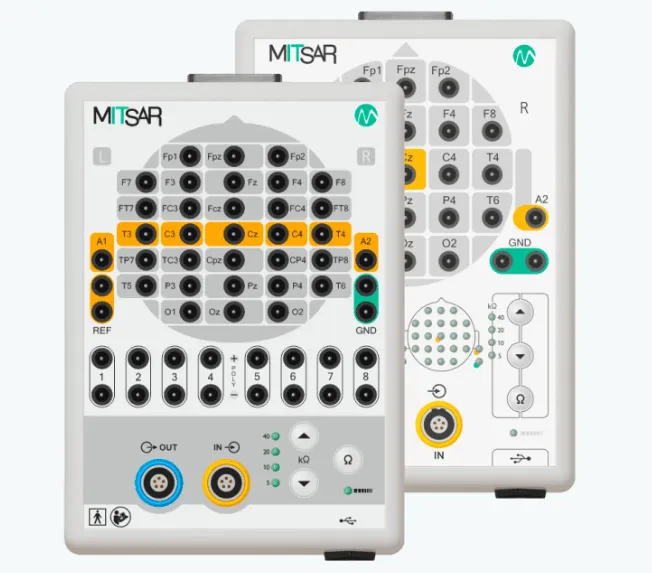


Mitsar The EEG-202 device is a 41-channel physiological acquisition device with 33 EEG channels and 8 bipolar channels. In addition, theThe acquisition system can also be used for video EEG monitoring and evoked (event-related) potentials, and the software has EEG/ERP/QEEG acquisition and analysis functions.Can be applied toGodEngineering Management, Psychology, RecognitionKnowing Neuroscience,Research in human factors engineering, human-computer interaction, human-computer-environment, cognitive neuroscience, brain science, and brain-computer interfaces.
Company Profile
Ltd, invested by Zhongke (Guangdong) Science Group and relying on Guangdong Human Factors Technology Research Institute and Wuhan Human Factors Engineering Technology Research Institute, is a new type of high-tech enterprise based on the direction of psychological human factors, driving human factors, biomechanics, user experience, virtual reality and other directions, integrating production, research and development, sales and technical services, and has been selected as a national high-tech enterprises, science and technology-based Small and Medium-sized Enterprises (SMEs) and Zhongguancun High-tech Enterprises.



Hengzhi Technology independently researches and develops driving human factors system, virtual reality graphical editing software, light environment psychological assessment system, psychological and human factors experimental teaching system, and at the same time as the general agent of Poland Cortivision near infrared, Russia Mitsar electroencephalography and Germany Eyelogic eye-tracking instrument in China, and the general agent of biomechanics and gait analysis scientific research products such as surface electromyography of Italy BTS, and so on. AdHawk Mindlink (Canada), QuaeroSys (Germany), Noldus (Holland), Tobii (Sweden), MindMedia (Holland), Biopac (U.S.A.), ETT (U.S.A.), and other products in the field of olfactory/gustatory stimulation. We have served Tsinghua University, Peking University, Beijing Normal University, Northeast Normal University, Yanshan University, Xi'an University of Architecture and Technology, Northwest Agriculture and Forestry University, Shenzhen University of Technology, Xi'an University of Science and Technology, Shanghai Jiaotong University, Xinjiang Normal University, Qiyuan Laboratory, China Electronics Technology Group 27, China Electronics Technology Group 28, Huawei Technology, InkScan, NetEase, Aerospace Academy II, and so on. Thousands of colleges and universities, research institutes and enterprises and institutions continue to carry out in-depth cooperation in talent cultivation, production and research cooperation, and transformation of achievements.












































